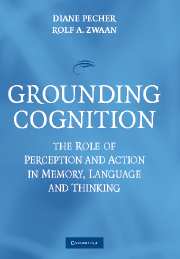Book contents
- Frontmatter
- Contents
- List of Contributors
- 1 Introduction to Grounding Cognition: The Role of Perception and Action in Memory, Language, and Thinking
- 2 Object Concepts and Action
- 3 Constraints on Spatial Language Comprehension: Function and Geometry
- 4 Embodiment in Metaphorical Imagination
- 5 Passionate Thoughts: The Emotional Embodiment of Moral Concepts
- 6 Grounding Language in Bodily States: The Case for Emotion
- 7 Situating Abstract Concepts
- 8 Dynamicity, Fictivity, and Scanning: The Imaginative Basis of Logic and Linguistic Meaning
- 9 The Emergence of Grammar from Perspective
- 10 Embodied Sentence Comprehension
- 11 On the Perceptual-Motor and Image-Schematic Infrastructure of Language
- 12 Connecting Concepts to Each Other and the World
- Author Index
- Subject Index
- References
3 - Constraints on Spatial Language Comprehension: Function and Geometry
Published online by Cambridge University Press: 22 July 2009
- Frontmatter
- Contents
- List of Contributors
- 1 Introduction to Grounding Cognition: The Role of Perception and Action in Memory, Language, and Thinking
- 2 Object Concepts and Action
- 3 Constraints on Spatial Language Comprehension: Function and Geometry
- 4 Embodiment in Metaphorical Imagination
- 5 Passionate Thoughts: The Emotional Embodiment of Moral Concepts
- 6 Grounding Language in Bodily States: The Case for Emotion
- 7 Situating Abstract Concepts
- 8 Dynamicity, Fictivity, and Scanning: The Imaginative Basis of Logic and Linguistic Meaning
- 9 The Emergence of Grammar from Perspective
- 10 Embodied Sentence Comprehension
- 11 On the Perceptual-Motor and Image-Schematic Infrastructure of Language
- 12 Connecting Concepts to Each Other and the World
- Author Index
- Subject Index
- References
Summary
Consider the following scenario. You arrive at work early one morning and head for the office coffeepot. A colleague of yours is already there pouring herself a cup of coffee. Upon seeing you, she says “Place your cup below the pot.” You interpret her statement as an indication that she will pour you a cup of coffee, and you put your cup in the appropriate location. Of interest in the current chapter are the processes and representations that underlie your apprehension of her utterance and your subsequent action. At a minimum, apprehension involves matching the relevant objects in the environment with the referents in the utterance (i.e., linking the cup in your hand with “your cup,” the coffee pot in her hand with “the pot”). For utterances of this type, these objects have different roles. One object is referred to as the located object, and it is the object whose location is being specified. It is also considered the focal object that is profiled in the utterance (Langacker, 1987; see also Zwaan & Madden, Chapter 10, this volume). The other object is referred to as the reference object. Due to its size, shape or salience within the discourse, the reference object is assumed to offer a viable reference point from which to define the location of the located object (Landau & Jackendoff, 1993; Langacker, 1993; Talmy, 1983). However, with respect to the goal of the utterance, this object is backgrounded relative to the located object (Langacker, 1987).
- Type
- Chapter
- Information
- Grounding CognitionThe Role of Perception and Action in Memory, Language, and Thinking, pp. 35 - 64Publisher: Cambridge University PressPrint publication year: 2005
References
- 4
- Cited by



